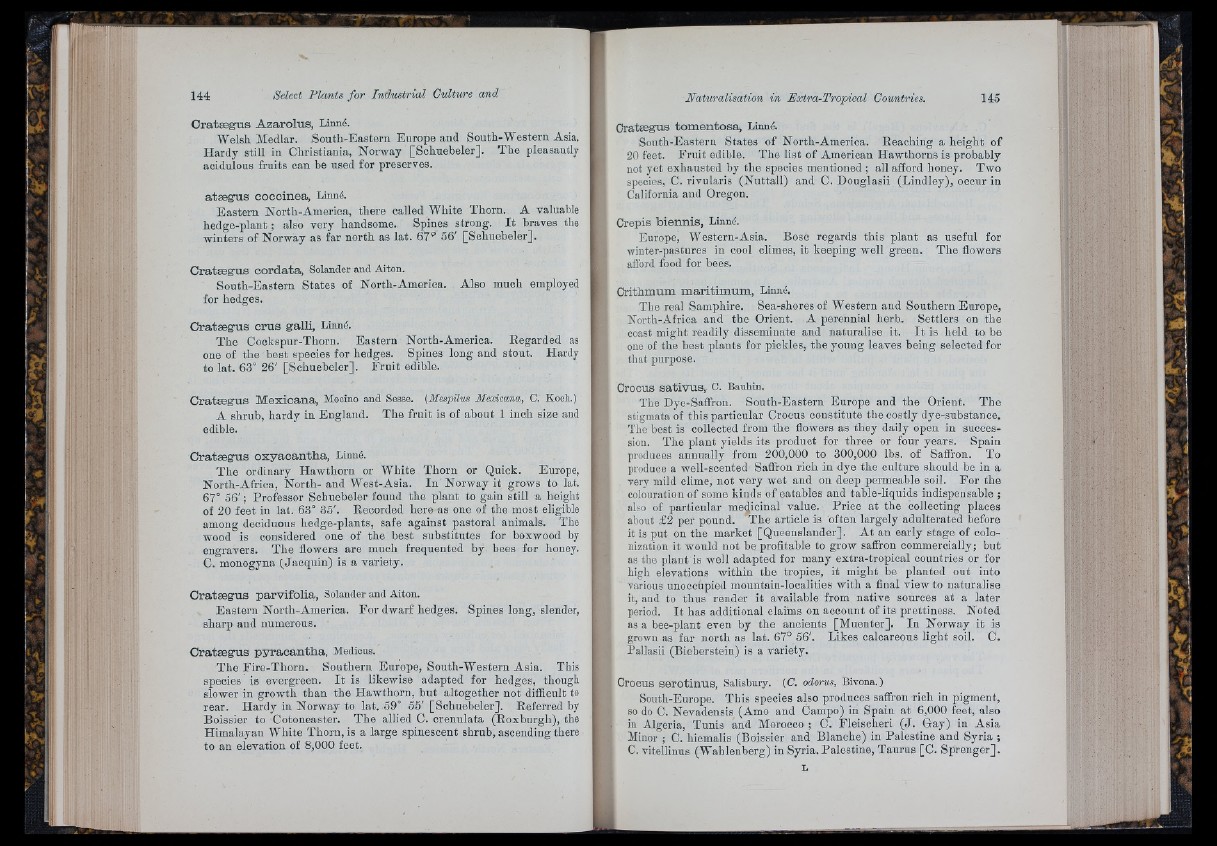
C r a tæ g u s A z a ro lu s , Linné.
Welsh Medlar. South-Eastern Europe and South-W'estern Asia.
Hardy still in Christiania, Norway [Schuebeler]. The pleasantly
acidulous fruits can be used for preserves.
a tæ g u s coooinea , Linné.
Eastern North-America, there called White Thorn. A valuable
hedge-plant ; also very handsome. Spines strong. I t braves the
winters of Norway as far north as lat. 67° 56' [Schuebeler].
C r a tæ g u s c o rd a ta , Solander and Aiton.
South-Eastern States of North-America. Also much employed
for hedges.
C r a tæ g u s c ru s gaUi, Linné.
The Cockspur-'Thorn. Eastern North-America. Regarded aa
one of the best species for hedges. Spines long and stout. Hardy
to lat. 63° 26' [Schuebeler]. F ru it edible.
C r a tæ g u s M ex ic a n a , Mooino and Sesse. (Mespilus Mexicana, C. Koch.)
A shrub, hardy iu England. The fruit is of about 1 inch size and
edible.
C r a tæ g u s o x y a c a n th a , Linné.
The ordinary Hawthorn or White Thorn or Quick. Europe,
North-Africa, North- and West-Asia. In Norway it grows to lat.
67° 56' ; Professor Schnebeler found the plant to gain still a height
of 20 feet in lat. 63° 35'. Recorded here as one of the most eligible
among deciduous hedge-plants, safe against pastoral animals. The
wood is considered one of the best substitutes for boxwood by
engravers. The flowers are much frequented by bees for honey.
C. monogyna (Jaoqnin) is a variety.
C r a tæ g u s p a rv ifo lia , Solander and Aiton.
Eastern North-America. For dwarf hedges. Spines long, slender,
sharp and numerous.
C r a tæ g u s p y r a c a n th a , Medicus.
The Fire-Thorn. Southern Europe, South-Western Asia. This
species is evergreen. I t is likewise adapted for hedges, though
slower in growth than the Hawthorn, hu t altogether not difficult to
rear. Hardy in Norway to lat. 59° 55' [Schuebeler]. Referred by
Boissier to Cotoneaster. 'The allied C. crennlata (Roxburgh), the
Himalayan White 'Thorn, is a large spinescent shrub, ascending there
to an elevation of 8,000 feet.
Cratægus tom e n to s a , Linné.
South-Eastern States of North-America. Reaching a height of
20 feet. F ru it edible. 'The list of American Hawthorns is probably
not yet exhausted by the species mentioned ; all afford honey. 'Two
species, C. rivularis (Nuttall) and C. Douglasii (Lindley), occur in
California and Oregon.
Crepis b ie n n is , Linné.
Europe, Western-Asia. Boso regards this plant as useful for
winter-pastures in cool climes, it keeping well green. The flowers
afford food for bees.
Crithmum m a r itim um , Linné.
The real Samphire. Sea-shores of Western and Southern Europe,
North-Africa and the Orient. A perennial herb. Settlers on the
coast might readily disseminate and naturalise it. I t is held to be
one of the best plants for pickles, the young leaves being selected for
that purpose.
Crocus sa tiv u s,. C. Bauhin.
The Dye-Saffron. South-Eastern Europe and the Orient. The
stigmata of this particular Crocus constitute tlie costly dye-substance.
The best is collected from the flowers as they daily open in succession.
The plant yields its product for three or four years. Spain
produces annually from 200,000 to 300,000 lbs. of Saffron. To
produce a well-scented Saffron rich in dye the culture should be in a
very mild clime, not very wet and on deep permeable soil. For the
colouration of some kinds of eatables and tabie-liquids indispensable ;
also of particular medicinal value. Price a t the collecting places
about £2 per pound. The article is often largely adulterated before
it is put on the market [Queenslander], A t an early stage of colonization
it would not be profitable to grow saffron commercially; but
as the plant is well adapted for many extra-tropical countries or for
high elevations within the tropics, it might be planted out into
various unoccupied mountain-localities with a final view to naturalise
it, aud to thus render it available from native sources at a later
period. I t has additional claims on account of its prettiness. Noted
as a bee-plant even by the ancients [Muenter]. In Norway it is
grown as far north as lat. 67° 56'. Likes calcareous light soil. C.
Pallasii (Bieberstein) is a variety.
Crocus s e ro tin u s , Salisbury. (C. odorus, Bivona.)
South-Europe. This species also produces saffron rich in pigment,
so do C. Nevadensis (Amo and Campo) in Spain a t 6,000 feet, also
■ in Algeria, Tunis and Morocco ; C. Fleischeri (J . Gay) in Asia
Minor ; C. hiemalis (Boissier and Blanche) in Palestine and Syria ;
C, vitellmus (Wahlenberg) in Syria. Palestine, Taurus [C. Sprenger].